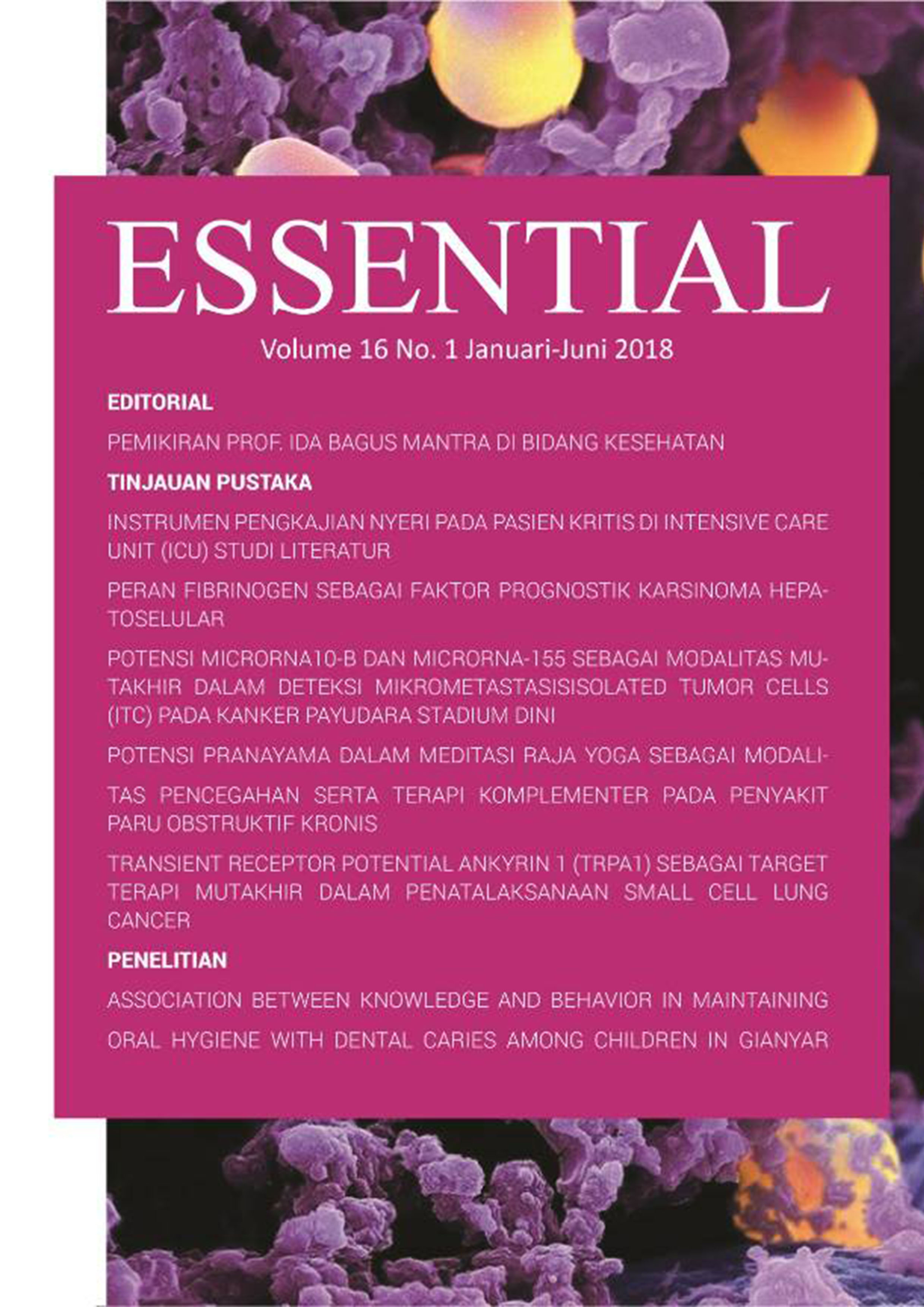POTENSI MICRORNA10-B DAN MICRORNA-155 SEBAGAI MODALITAS MUTAKHIR DALAM DETEKSI MIKROMETASTASIS/ISOLATED TUMOR CELLS (ITC) PADA KANKER PAYUDARA STADIUM DINI
Abstract
Pendahuluan: Metastasis merupakan penyebab kematian utama pada kasus kanker payudara. Metastasis diawali dengan mikrometastasis/isolated tumor cells (ITC) yang dapat terekspresi pada sirkulasi darah tepi (Circulating Tumor Cells/CTC) atau sumsum tulang (Disseminated Tumor Cells/DTC). Identifikasi mikrometastasis penting dilakukan sebagai upaya mendeteksi distant metastasis pada masa mendatang. Sampai saat ini belum ada pemeriksaan mikrometastasis yang efektif. Untuk itu, perlu adanya modalitas screening metastasis kanker payudara dengan biomarker miR-10b dan miR-155.
Metode: Tinjauan pustaka disusun berdasarkan literatur seperti jurnal dan website. Kata kunci yang digunakan yaitu “EMT”, “kanker payudara”, “mikrometastasis”, “miR-10b” dan “miR-155” pada search engine scholar.google.com ,www.nature.com dan Pubmed. Dari 80 jurnal yang ditelaah, 70 jurnal ditemukan sesuai dengan topik bahasan dan digunakan sebagai referensi karya ini.
Pembahasan: Proses metastasis kanker payudara didahului oleh mikrometastasis yang berkaitan dengan epithelial-mesenchymal transition (EMT). Proses EMT mengekspresikan beberapa faktor yakni SNAI1 , SNAI2 dan Twist yang berkorelasi dengan peningkatan ekspresi miR-10b secara signifikan. MiR-155 sebagai biomarker yang memilliki peran penting dalam regulasi transforming growth factor ? (TGF-?). TGF-? merupakan regulator dari EMT, sehingga miR-155 berkorelasi dengan proses EMT. MiR-155 dan miR-10b memiliki keunggulan baik sensitivitas maupun spesifisitas serta dengan prosedur invasif minimal sehingga jika dikombinasikan dapat menjadi agen potensial biomarker metastasis kanker payudara. Simpulan: MiR-10b dan miR-155 merupakan agen potensial dalam deteksi metastasis kanker payudara. Penelitian lebih lanjut diperlukan untuk mengetahui efektivitas kombinasi miR-10b dan miR-155 dalam mendeteksi metastasis kanker payudara untuk menambah bukti ilmiah.
Downloads
References
2. Siegel RL, Miller KD, Jemal A. Cancer statistics, 2016. CA Cancer J Clin [Internet]. Jan [cited 2016 Aug 20];66(1):7–30. Available from: http://www.ncbi.nlm.nih.gov/pubmed/26742998
3. Ferlay J, Soerjomataram I, Dikshit R, Eser S, Mathers C, Rebelo M, et al. Cancer incidence and mortality worldwide: Sources, methods and major patterns in GLOBOCAN 2012. Int J Cancer. 2015;136(5):e359–86.
4. Monteiro J, Fodde R. Cancer stemness and metastasis: Therapeutic consequences and perspectives. Eur J Cancer [Internet]. 2010;46(7):1198–203. Available from: http://dx.doi.org/10.1016/j.ejca.2010.02.030
5. Alečković M, Kang Y. Regulation of cancer metastasis by cell-free miRNAs. Biochim Biophys Acta - Rev Cancer. 2015;1855(1):24–42.
6. McGuire A, Brown JAL, Kerin MJ. Metastatic breast cancer: the potential of miRNA for diagnosis and treatment monitoring. Cancer Metastasis Rev. 2015;34(1):145–55
7. Kang P, Liao M, Wester MR, Leeder JS, Pearce RE. NIH Public Access. Ratio. 2010;36(3):490–9.
8. Jemal A, Bray F, Center MM, Ferlay J, Ward E, Forman D. Global cancer statistics. CA Cancer J Clin [Internet]. 2011;61(2):69–90. Available from: http://www.ncbi.nlm.nih.gov/pubmed/21296855
9. Coughlin SS, Ekwueme DU. Breast cancer as a global health concern. Cancer Epidemiol. 2009;33(5):315–8.
10. Nicolini A, Giardino R, Carpi A, Ferrari P, Anselmi L, Colosimo S, et al. Metastatic breast cancer: an updating. Biomed Pharmacother [Internet]. 2006;60(9):548–56. Available from: http://linkinghub.elsevier.com/retrieve/pii/S0753332206002496%0Ahttp://www.ncbi.nlm.nih.gov/pubmed/16950593
11. Yardley DA. Visceral Disease in Patients With Metastatic Breast Cancer: Efficacy and Safety of Treatment With Ixabepilone and Other Chemotherapeutic Agents. Clin Breast Cancer [Internet]. 2017 Jan 6;10(1):64–73. Available from: http://dx.doi.org/10.3816/CBC.2010.n.009
12. Edge SB, Compton CC. The American Joint Committee on Cancer: the 7th edition of the AJCC cancer staging manual and the future of TNM. Ann Surg Oncol [Internet]. 2010;17(6):1471–4. Available from: http://www.ncbi.nlm.nih.gov/pubmed/20180029
13. Boer M De, Deurzen CHM Van, Borm GF, Diest PJ Van, Adang EMM, Nortier JWR, et al. new england journal. 2009;653–63.
14. Theodoropoulos PA, Polioudaki H, Agelaki S, Kallergi G, Saridaki Z, Mavroudis D, et al. Circulating tumor cells with a putative stem cell phenotype in peripheral blood of patients with breast cancer. Cancer Lett [Internet]. 2010;288(1):99–106. Available from: http://dx.doi.org/10.1016/j.canlet.2009.06.027
15. Gorges TM, Pantel K. Circulating tumor cells as therapy-related biomarkers in cancer patients. 2013;931–9.
16. Trumpp A, Wiestler OD. Mechanisms of Disease: cancer stem cells--targeting the evil twin. Nat Clin Pract Oncol. 2008;5(6):337–47.
17. Tseng SPLLWW. Micrometastatic Cancer Cells in Lymph Nodes, Bone Marrow, and Blood. CA Cancer J Clin. 2014;64(3):195–206
18. Pantel K, Alix-Panabières C, Riethdorf S. Cancer micrometastases. Nat Rev Clin Oncol [Internet]. 2009;6(6):339–51. Available from: http://dx.doi.org/10.1038/nrclinonc.2009.44
19. Cheng G, Kurita S, Torigian DA, Alavi A. Current status of sentinel lymph-node biopsy in patients with breast cancer. Eur J Nucl Med Mol Imaging. 2011;38(3):562–75.
20. Iqbal J, Ginsburg O, Giannakeas V, Rochon PA, Semple JL, Narod SA. The impact of nodal micrometastasis on mortality among women with early-stage breast cancer. Breast Cancer Res Treat. 2016;1–13.
21. Lin H, Balic M, Zheng S, Datar R, Cote RJ. Disseminated and circulating tumor cells: Role in effective cancer management. Crit Rev Oncol Hematol [Internet]. 2011;77(1):1–11. Available from: http://dx.doi.org/10.1016/j.critrevonc.2010.04.008
22. Pantel K, Alix-Panabières C. Circulating tumour cells in cancer patients: Challenges and perspectives. Trends Mol Med. 2010;16(9):398–406.
23. Wiatrek R, Kruper L. Sentinel lymph node biopsy indications and controversies in breast cancer. Maturitas [Internet]. 2011;69(1):7–10. Available from: http://dx.doi.org/10.1016/j.maturitas.2011.02.006
24. Mitchell PS, Parkin RK, Kroh EM, Fritz BR, Wyman SK, Pogosova-Agadjanyan EL, et al. Circulating microRNAs as stable blood-based markers for cancer detection. Proc Natl Acad Sci USA [Internet]. 2008;105(30):10513–8. Available from: http://www.ncbi.nlm.nih.gov/pubmed/18663219
25. Paranjape T, Slack FJ, Weidhaas JB. MicroRNAs: tools for cancer diagnostics. Gut [Internet]. 2009;58(11):1546–54. Available from: http://www.ncbi.nlm.nih.gov/pubmed/19834118%5Cnhttp://www.pubmedcentral.nih.gov/articlerender.fcgi?artid=PMC2802653
26. Wuchty S, Arjona D, Bozdag S, Bauer PO. Involvement of microRNA families in cancer. Nucleic Acids Res. 2012;40(17):8219–26.
27. Bhagavathi S, Czader M. MicroRNAs in benign and malignant hematopoiesis. Arch Pathol Lab Med. 2010;134(9):1276–81.
28. Roth C, Rack B, Müller V, Janni W, Pantel K, Schwarzenbach H. Circulating microRNAs as blood-based markers for patients with primary and metastatic breast cancer. 2010;6–13.
29. Meng F, Wu G. The rejuvenated scenario of epithelial-mesenchymal transition (EMT) and cancer metastasis. Cancer Metastasis Rev. 2012;31(3–4):455–67.
30. Ma L, Teruya-Feldstein J, Weinberg R a. Tumour invasion and metastasis initiated by microRNA-10b in breast cancer. Nature. 2007;449(7163):682–8.
31. Kong W, Yang H, He L, Zhao J, Coppola D, Dalton WS, et al. MicroRNA-155 Is Regulated by the Transforming Growth Factor beta/Smad Pathway and Contributes to Epithelial Cell Plasticity by Targeting RhoA. Mol Cell Biol. 2008;28(22):6773–84.
32. Zavadil J, Narasimhan M, Blumenberg M, Schneider RJ. Transforming Growth Factor-β and microRNA:mRNA Regulatory Networks in Epithelial Plasticity. Cells Tissues Organs [Internet]. 2007;185(1–3):157–61. Available from: http://www.karger.com/DOI/10.1159/000101316
33. Eichelser C, Flesch-Janys D, Chang-Claude J, Pantel K, Schwarzenbach H. Deregulated serum concentrations of circulating cell-free microRNAs miR-17, miR-34a, miR-155, and miR-373 in human breast cancer development and progression. Clin Chem. 2013;59(10):1489–96.
34. Centers for Disease Control. What Is Breast Cancer? Control, Division of Cancer Prevention and Prevention, Centers for Disease Control and. 2016.
35. Malhotra GK, Zhao X, Band H, Band V. Histological, molecular and functional subtypes of breast cancers. Cancer Biol Ther. 2010;10(10):955–60
36. Foulkes W, Smith I, Reis-Filho J. Triple-Negative Breast Cancer. N Engl J Med. 2010;363(20):1938–48.
37. Saijo CJH, G. van de VD, Haller; David J. Kerr; Michael Baumann; Nagahiro. Oxford Textbook of Oncology. Oxford Textb Oncol. 2016;3–10.
38. Kabel AM, Baali FH. Breast Cancer : Insights into Risk Factors , Pathogenesis , Diagnosis and Management. 2015;3(2):28–33.
39. Koboldt DC, Fulton RS, McLellan MD, Schmidt H, Kalicki-Veizer J, McMichael JF, et al. Comprehensive molecular portraits of human breast tumours. Nature. 2012;490(7418):61–70.
40. Kumar V, Abbas AK, Aster JC. Robbins Basic Pathology. 9th ed. Klatt E c, Kumar R, Mitchell RN, editors. basic pathology. Philadelphia, Pennsylvania: Elsevier Inc; 2013. 716-762 p.
41. Banerjee S, Dowsett M, Ashworth A, Martin L-A. Mechanisms of disease: angiogenesis and the management of breast cancer. Nat Clin Pract Oncol. 2007;4(9):536–50.
42. Schneider BP, Miller KD. Angiogenesis of breast cancer. J Clin Oncol. 2005;23(8):1782–90.
43. Scully OJ, Bay B-H, Yip G, Yu Y. Breast cancer metastasis. Cancer Genomics Proteomics [Internet]. 2012;9(5):311–20. Available from: http://www.ncbi.nlm.nih.gov/pubmed/22990110
44. Weigelt B, Peterse JL, van ’t Veer LJ. Breast cancer metastasis: markers and models. Nat Rev Cancer. 2005;5(August):591–602.
45. Thiery JP, Morgan M. Breast cancer progression with a Twist. Nat Med. 2004;10(8):777–8.
46. Felipe Lima J, Nofech-Mozes S, Bayani J, Bartlett J. EMT in Breast Carcinoma—A Review. J Clin Med. 2016;5(7):65.
47. Wang Y, Liu J, Ying X, Lin PC, Zhou BP. Twist-mediated Epithelial-mesenchymal Transition Promotes Breast Tumor Cell Invasion via Inhibition of Hippo Pathway. Sci Rep. 2016;6(April):24606.
48. Lander R, Nasr T, Ochoa SD, Nordin K, Prasad MS, Labonne C. Interactions between Twist and other core epithelial-mesenchymal transition factors are controlled by GSK3-mediated phosphorylation. Nat Commun. 2013;4:1542.
49. Smith BN, Burton LJ, Henderson V, Randle DD, Morton DJ, Smith BA, et al. Snail promotes epithelial mesenchymal transition in breast cancer cells in part via activation of nuclear ERK2. PLoS One. 2014;9(8).
50. Wu Y, Zhou BP. Snail More than EMT. 2010;(June):199–203.
51. Wang Y, Shi J, Chai K, Ying X, Zhou BP. The Role of Snail in EMT and Tumorigenesis. 2014;2(4):2733–52.
52. Abba ML, Patil N, Leupold JH, Allgayer H. MicroRNA Regulation of Epithelial to Mesenchymal Transition. 2016;
53. Lu Y, Cheng A. Cancer Science & Research : Open Access Pathological Function and Clinical Significance of Microrna- 10b in Cancer. 2014;
54. Bourguignon LYW, Wong G, Earle C, Krueger K, Spevak CC. Hyaluronan-CD44 interaction promotes c-Src-mediated twist signaling, microRNA-10b expression, and RhoA/RhoC up-regulation, leading to Rho-kinase-associated cytoskeleton activation and breast tumor cell invasion. J Biol Chem. 2010;285(47):36721–35.
55. Paranjape T, Slack FJ, Weidhaas JB. MicroRNAs: tools for cancer diagnostics. Gut. 2009;58(11):1546–54.
56. Farazi TA, Spitzer JI, Morozov P, Tuschl T. NIH Public Access. Brain [Internet]. 2012;32(2):1–8. Available from: http://www.pubmedcentral.nih.gov/articlerender.fcgi?artid=3170756&tool=pmcentrez&rendertype=abstract
57. Li M, Ding X, He M, Cheng S. microRNA and cancer. AAPS J. 2010;12(3):309–17.
58. Wang J, Zhang K-Y, Liu S-M, Sen S. Tumor-Associated Circulating MicroRNAs as Biomarkers of Cancer. Vol. 19, Molecules . 2014.
59. Kala R, Peek GW, Hardy TM, Tollefsbol TO. MicroRNAs: an emerging science in cancer epigenetics. J Clin Bioinforma. 2013;3(1):6.
60. Hulf T, Sibbritt T, Wiklund ED, Bert S, Strbenac D, Statham AL, et al. Discovery pipeline for epigenetically deregulated miRNAs in cancer: integration of primary miRNA transcription. BMC Genomics [Internet]. 2011;12(1):54. Available from: http://dx.doi.org/10.1186/1471-2164-12-54
61. Turchinovich A, Weiz L, Langheinz A, Burwinkel B. Characterization of extracellular circulating microRNA. Nucleic Acids Res. 2011;39(16):7223–33.
62. Hunter MP, Ismail N, Zhang X, Aguda BD, Lee EJ, Yu L, et al. Detection of microRNA expression in human peripheral blood microvesicles. PLoS One. 2008;3(11).
63. Kalluri R, Weinberg R a. Review series The basics of epithelial-mesenchymal transition. J Clin
Invest. 2009;119(6):1420–8.
64. Chua HL, Bhat-Nakshatri P, Clare SE, Morimiya A, Badve S, Nakshatri H. NF-kappaB represses E-cadherin expression and enhances epithelial to mesenchymal transition of mammary epithelial cells: potential involvement of ZEB-1 and ZEB-2. Oncogene. 2007;26(5):711–24.
65. Yang J, Mani SA, Donaher JL, Ramaswamy S, Itzykson RA, Come C, et al. Twist, a master regulator of morphogenesis, plays an essential role in tumor metastasis. Cell. 2004;117(7):927–39.
66. Chen W, Cai F, Zhang B, Barekati Z, Zhong XY. The level of circulating miRNA-10b and miRNA-373 in detecting lymph node metastasis of breast cancer: potential biomarkers. Tumour Biol [Internet]. 2013;34(1):455–62. Available from: http://www.ncbi.nlm.nih.gov/pubmed/23238818
67. Higgs G, Slack F. The multiple roles of microRNA-155 in oncogenesis. J Clin Bioinforma [Internet]. 2013;3(1):17. Available from: http://jclinbioinformatics.biomedcentral.com/articles/10.1186/2043-9113-3-17
68. Heneghan HM, Miller N, Lowery AJ, Sweeney KJ, Newell J, Kerin MJ. Circulating microRNAs as novel minimally invasive biomarkers for breast cancer. Ann Surg. 2010;251(3):499–505.
69. Iorio M V., Casalini P, Tagliabue E, Ménard S, Croce CM. MicroRNA profiling as a tool to understand prognosis, therapy response and resistance in breast cancer. Eur J Cancer. 2008;44(18):2753–9.
70. Bartkowiak K, Wieczorek M, Buck F, Harder S, Moldenhauer J, Effenberger KE, et al. Two-Dimensional Differential Gel Electrophoresis of a Cell Line Derived from a Breast Cancer Micrometastasis Revealed a Stem/Progenitor Cell Protein Profile. J Proteome Res [Internet]. 2009 Apr 3;8(4):2004–14. Available from: http://dx.doi.org/10.1021/pr8009758


 SUBMISSION
SUBMISSION
















